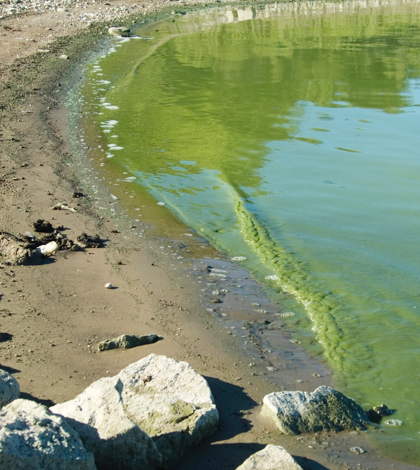The State Water Resources Control Board is now reporting the identification of a toxic cyanobacteria (blue-green algae) bloom in Grantline Canal and Old River surrounding Fabian Tract in San Joaquin County, near both Tracy and Mountain Horse. Ongoing monitoring has discovered an extensive cyanobacteria bloom of Microcystis occurring in the waterways surrounding Fabian Tract. Additionally, cyanotoxin microcystin has been confirmed by testing to be at concentrations that exceed the trigger levels for the protection of human health from the California Cyanobacteria and Harmful Algal Bloom Network’s Voluntary Guidance.
As with most of the algae blooms that have been identified this summer, authorities are urging, swimmers, boaters and recreational users are urged to use caution and to avoid direct contact with, or use of, the water when recreating in these waters. Dogs and livestock should be kept out of the water and should not be allowed to drink the water or eat algal material along the shoreline. Due to the potential health risks, the San Joaquin County Environmental Health Department (SJC EHD) has posted health advisories at the local marinas.
The discovery of blue-green algae in the south Delta is the latest of such discoveries – and the subsequent warnings and cautions – that have been found and issued this year. From Discovery Bay to the north and Silverwood Lake in San Bernardino County to the south, 2016 has been laden with toxic cyanobacteria blooms.
Cyanobacteria blooms can appear as bright green with white or brown foam, scum or mats that float on the water’s surface. Scums and mats can accumulate along the shoreline and in boat ramp and boat dock areas. The blooms are often fed by nutrients from farms, cities and golf courses. California’s ongoing drought and warmer-than-normal temperatures are believed to contribute to the problem.
Ingestion of algal material, scums and mats could be dangerous. Children should be kept away from algae in the water or on the shore. Children should not play in the shallows with algae material, scum or dried algal mats and not put algae in their mouths. Recreational exposure to cyanobacteria and associated toxins can cause eye irritation, allergic skin rash, mouth ulcers, vomiting, diarrhea, and cold and flu-like symptoms.
Dogs and livestock are in danger because they tend to eat the algae and drink the water. Dog deaths have occurred in California each year from this type of exposure so care should be taken to keep them out of the water or from playing in algal mats or scum accumulated on the shore. If they do swim in the water, they should be rinsed off with fresh water to remove any algae from their fur.
The Statewide Guidance on Cyanobacteria and Harmful Algal Blooms recommends the following for waters impacted by cyanobacteria:
- Keep pets and livestock out of the water. Do not allow them to drink the water or eat algal material on shore. If they do get in the water, do not let them drink the water, swim through algae, scums or mats, or lick their fur after going in the water. Rinse pets in clean water to remove algae and toxins from fur.
- Avoid areas of accumulated algae, scums or mats when wading, swimming, or jet or water skiing.
- Do not drink untreated surface water from these areas or use it for cooking; People should not eat mussels or other bivalves collected from these areas. Limit or avoid eating fish from these areas; if fish are consumed, remove the guts and liver, and rinse filets in clean drinking water.
- Get medical treatment immediately if you think that you, your pet, or livestock might have been poisoned by cyanobacteria toxins. Be sure to alert medical professionals to the possible exposure with cyanobacteria. Also, make sure to contact the local county public health department.
The anticipated fall weather – and any long-hoped-for rains – should help mitigate blue-green algae blooms, say authorities.
In the case of San Joaquin County (SJC), site of the most recent outbreak in the south Delta, experts from the Environmental Health Department (EHD) did recently ensure warning signs, placed earlier this year at local marinas in the south Delta, were still in place. Local veterinarians have also been placed on alert.
“We’re just trying to send the message out and be really proactive,” said Lisa Medina of the SJC EHD.
 California Water News Daily Your Source For Water News in California
California Water News Daily Your Source For Water News in California


